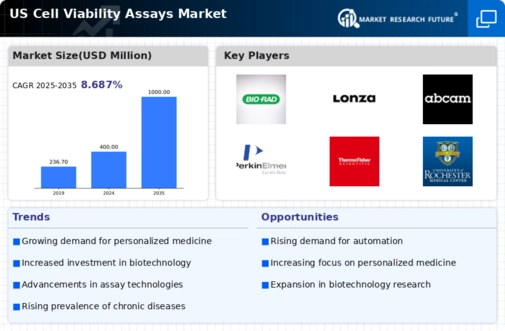Increased Research Funding
The cell viability-assays market is experiencing growth due to increased funding for research initiatives in the US. Government and private sector investments in biomedical research have surged, with funding reaching approximately $45 billion in 2025. This influx of capital supports the development of advanced cell viability assays, which are essential for drug discovery and toxicology studies. As researchers seek to understand cellular responses to various compounds, the demand for reliable and efficient assays rises. Consequently, this trend is likely to bolster the cell viability-assays market, as more laboratories adopt these technologies to enhance their research capabilities.
Expansion of Biotechnology Sector
The biotechnology sector in the US is witnessing rapid expansion. This expansion positively influences the cell viability assays market. With the biotechnology industry projected to grow at a CAGR of 7.4% from 2025 to 2030, the demand for innovative cell viability assays is likely to increase. Biotech companies require these assays for various applications, including drug development, genetic research, and regenerative medicine. As the sector continues to evolve, the cell viability-assays market is expected to benefit from the growing need for advanced testing methods that can accurately assess cell health and viability.
Advancements in Assay Technologies
Technological advancements in assay methodologies are significantly shaping the cell viability-assays market. Innovations such as high-throughput screening and automated systems are enhancing the efficiency and accuracy of cell viability testing. In 2025, The market for high-throughput screening technologies is expected to reach $3 billion in the US. This indicates a strong trend towards automation in laboratory settings. These advancements not only improve the reliability of results but also reduce the time and resources required for testing. As laboratories adopt these cutting-edge technologies, the cell viability-assays market is poised for substantial growth.
Rising Incidence of Chronic Diseases
The increasing prevalence of chronic diseases in the US drives the demand for cell viability assays. As conditions such as cancer, diabetes, and cardiovascular diseases become more common, there is a heightened need for effective therapeutic interventions. The cell viability-assays market plays a crucial role in the development of new treatments, as these assays are essential for evaluating the efficacy and safety of potential drugs. With chronic diseases affecting millions of Americans, the market for cell viability assays is likely to see sustained growth as researchers and pharmaceutical companies strive to address these health challenges.
Growing Focus on Personalized Medicine
The shift towards personalized medicine is significantly impacting the cell viability-assays market. As healthcare providers increasingly tailor treatments to individual patient profiles, the need for precise and reliable assays becomes paramount. In 2025, the personalized medicine market is projected to reach $2 trillion in the US, driving demand for cell viability assays that can evaluate patient-specific responses to therapies. This trend suggests that the cell viability-assays market will expand as pharmaceutical companies and research institutions invest in developing assays that cater to personalized treatment approaches, thereby enhancing patient outcomes.





















Leave a Comment